Byzantine Coins of Basil I, "The Macedonian," 867-886, and Leo VI, 886-912, "The Wise."
Basil was elevated to joint rule by his predecessor, Michael III, who had come to the throne at age six when Michael's father Theophilus took ill and died in 842. Michael III had his mother as regent until he was about 20 when her brother Bardas removed her. Michael III remained sole emperor but was content to let advisors run the empire. In 866 Michael, at age 30, proclaimed Basil I, formerly a lowly stablehand, his co-emperor. Bad decision. The next year Basil murdered Michael and assumed sole rule as the founder of the "Macedonian Dynasty," rulers of the Byzantine empire from 867 to 1056.
What's new? 2022, Dec. 24. Three additional examples and some new commentary.
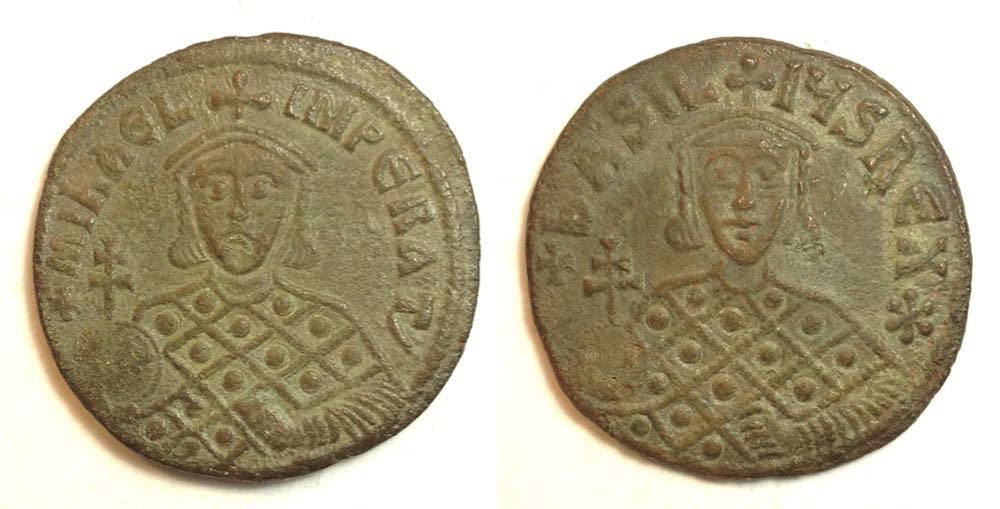 Michael III, "the drunkard," 842-867 and Basil I, 867-886.
Michael III, "the drunkard," 842-867 and Basil I, 867-886.
26 mm. 7.67 grams.
Struck in the last year of Michael's reign.
+MIҺAЄL IMPЄRAT ', facing bust of Michael in loros
+bASIL-IVS RЄX*, facing bust of Basil in loros
The legends use the Latin terms imperator for Michael and rex for Basil which are titles not seen on other Byzantine coins.
In the sixth century Byzantine-coin inscriptions were entirely in Latin. Gradually legends began to mix Latin and Greek until in the eighth and ninth centuries the legends are almost entirely in Greek. In 865 Rome ridiculed the Byzantines by saying they didn't even know Latin and Michael III responded with this unique type. [Grierson, p. 39] Mike Braunlin noted, "Michael had criticized the Latin language as a "barbarous and Scythian tongue" in a letter to Pope Nicholas I. The curial reply was that it was "ridiculous for the emperors to call themselves Roman if they were ignorant of Latin" (quia ridiculum est vos apellare Romanorum imperatores et tamen linguam non nosse Romanam). This coin inscription was "evidence" that Latin was alive and well in Constantinople!"
Each holds a patriarchal globus cruciger.
Sear 1693. This type with Michael III on one side and Basil I on the other is rare. Here is a second example with a much-different surface:
 25 mm. 6.98 grams.
25 mm. 6.98 grams.
MIҺAЄL IMPЄRAT ', facing bust of Michael in loros
bASIL-IVS RЄX, facing bust of Basil in loros
Sear 1693.
The first issue of Basil I included his infant son.
Portrait Convention: When a Byzantine coin has two figures on one side, the higher ranking person is on the viewer's left.
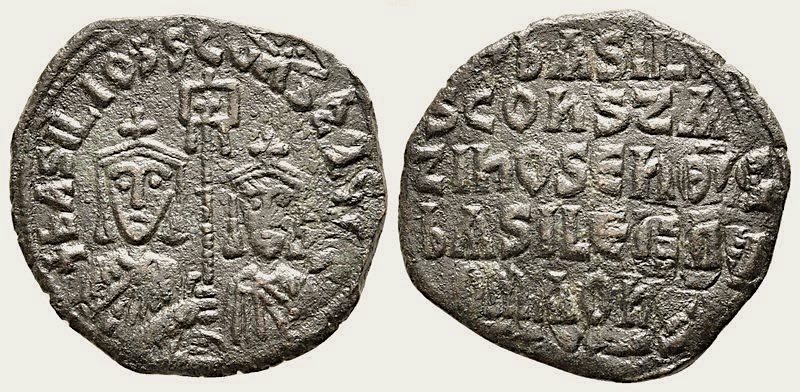 Basil I and his eldest son, Constantine
Basil I and his eldest son, Constantine
26 mm. 7.60 grams.
Struck in the winter months of 867/8.
Facing busts, both in chlamys, Constantine on our right only slightly smaller, even though he was just a child.
+bASILIOS S COҺSTAҺTIҺ..AVGG
Reverse legend in five lines:
+bASIL (Basil)
S COҺSTAҺ (and Constantine)
TIҺOS ЄҺΘO (by the grace of God)
bASILЄIS R (kings of the)
OMAOҺ (Romans)
Sear 1721. DO 8.
Sear attributes this type to an "uncertain provincial mint," but Grierson in Dumbarton Oaks III part 2 gives it to Constantinople because there are mules with the next type which is certainly from Constantinople. It was thought to be from a provincial mint because the workmanship is poor, but Grierson explains this differently. He notes that very few copper coins had been issued at Constantinople for the 25 years of the previous reign and this type was the first of his reign, usually overstruck on earlier types, by a mint out of practice. It was issued for the elevation of Constantine, "a hasty and short-lived issue in the winter months of 867/8."
Comment for Collectors: Quality control was not a Byzantine goal for coin production. Most were not well-engraved and well-struck and most are very worn, so Byzantine coins usually have numerous faults. It is often difficult or impossible to find an example that is pleasing in all regards. It is very common that when two coins of the same type are compared, one is better in some ways and worse in others. When Bendall and Donald wrote their identification guide The Later Palaeologan Coinage they used line-drawings in order to be able to illustrate all the details of each type in one picture because photographs could not do the job--individual coins almost never had all the details. Coins are not quite so bad in this earlier era, but, even examples that are good "for type" may not show all the details.
Clearly the busts are not portraits with individual features. Sometimes coins show a beard, short or long, or no beard, as an indication of age. On this coin rank is all that is shown--Constantine, his oldest son, has been made co-ruler. The type has the co-rulers with two busts of very similar size which was by then traditional. The type above merely continued the tradition. The next type is different for differentiating the rulers by size.
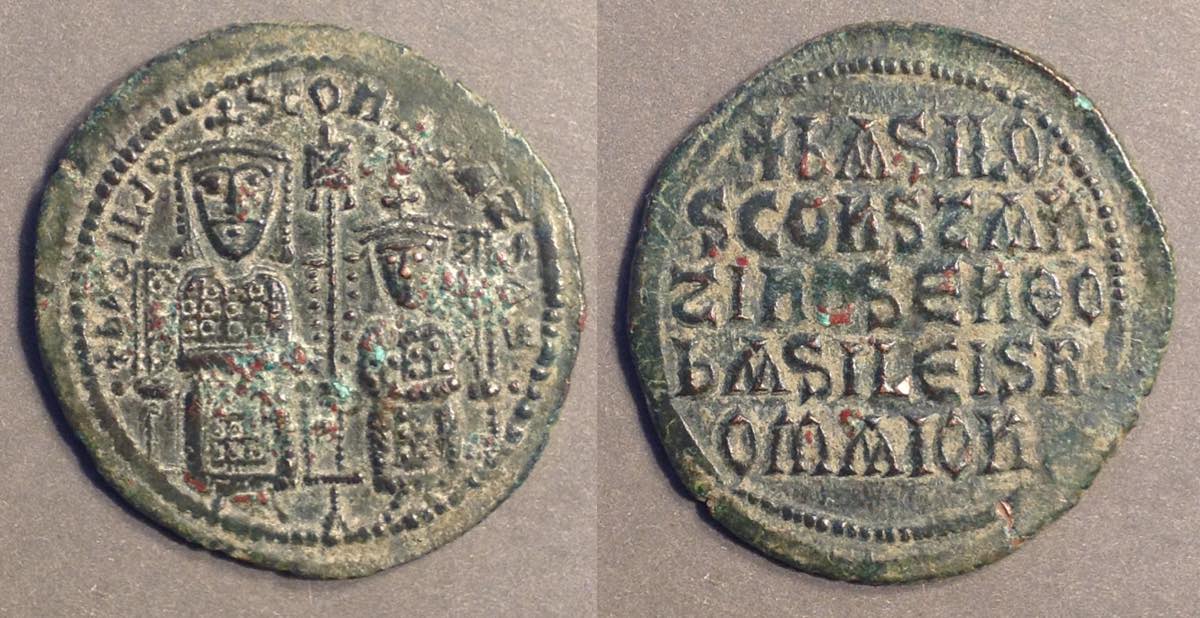 Basil I (867-886) and Constantine (868-887)
Basil I (867-886) and Constantine (868-887)
28 mm. 6.92 grams.
Struck 868-870
+bASILIO S CONST [ANT AVGG]
Rulers seated on throne, each in modified loros (unlike the chlamys of the previous type) with Constantine distinctly smaller.+bASILO
S CONSRAN
TINOSЄNΘO
bASILISЄR
OMAION
Sear 1710. DO 9. Constantinople.
Portrait Convention: When a Byzantine coin has three figures on one side, the highest ranking person is in the middle, the second on our right, and the third on our left.
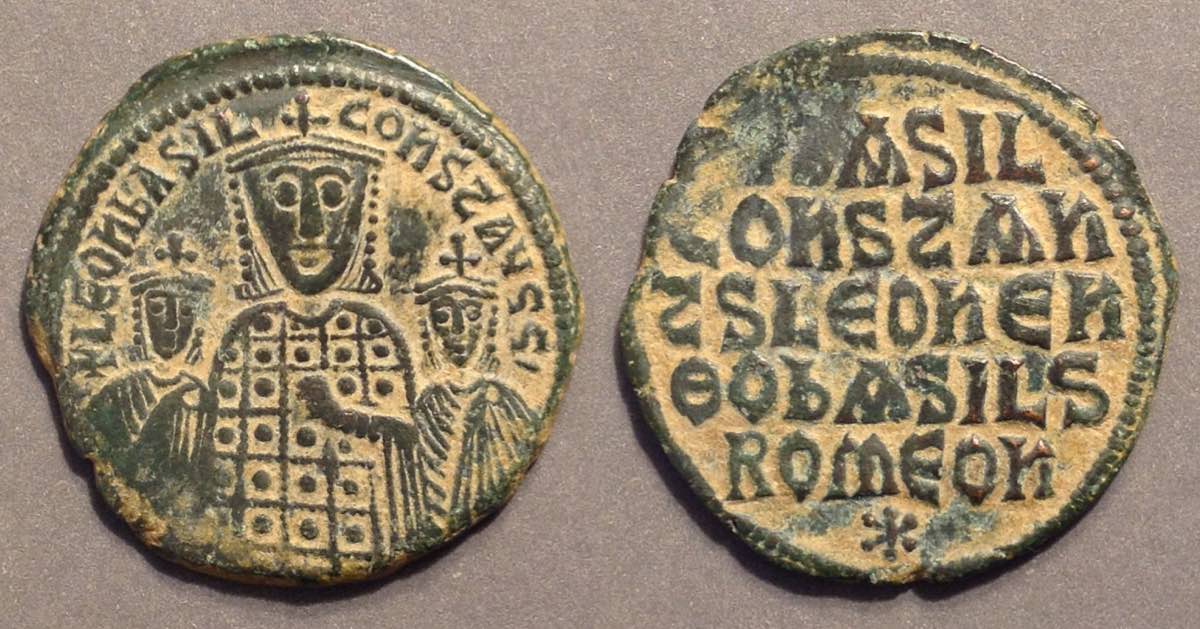 Basil I, the Macedonian, 867-886
Basil I, the Macedonian, 867-886
with his sons Leo VI and Constantine (the eldest son, who predeceased Basil). Struck 870-879.
27-26 mm. 6.9 grams.
+LЄOҺ bASIL COҺST AVGG (labeling the rulers left to right)
5-line reverse legend (labeling the rulers most important to least imporant)
+bASIL (Basil)
COҺSTAҺ (Constantine)
T S LЄOҺ ЄҺ (and Leo, by the grace of God)
ΘO bASILS (King of the)
ROMЄOҺ (Romans)
Sear 1712. DO 11. Constantinople mint.The ranking emperor, Basil, is in the middle and much larger. Constantine is on the right (as we see it), second in the reverse legend and slightly larger than Leo, who smaller on the left and third in the reverse legend.
 Another example of Sear 1712, with a much-different surface.
Another example of Sear 1712, with a much-different surface.
Basil I, the Macedonian, 867-886
with his sons Leo VI and Constantine. Struck 870-879.
27 mm. 8.28 grams.
This is an extremely similar type, Sear 1713, which lacks the tiny "left hand holding akakia" visible just above 5:30 on the obverse of this coin.
Constantine was Basil's son by his first wife before he became emperor in 867. Constantine died in 879 for reasons unknown to us. Basil was devastated. Leo (Basil's second son, who became the next emperor, Leo VI) was next in line to the throne, but Basil dropped all reference on coins to Leo, possibly because he thought Leo was not really his biological son. The story is that before Basil became emperor he married, as his second wife, the mistress of Michael III who later gave birth to Leo. Rumor had it that Leo was really the son of Michael III, not Basil, and likely Basil believed it, too. In any case, he hated Leo and even had him imprisoned for conspiring. Nevertheless, Leo remained next in line and did assume the throne when Basil died, supposedly from a hunting accident.
 Basil I, alone. Struck 879-886.
Basil I, alone. Struck 879-886.
28-27 mm. 9.62 grams.
+bASILIO S bASILЄVS
Basil in loros on throne with curved arms ("winged throne")
+bASIL
IOS ЄҺΘЄC
bASILЄVS
ROMEOҺ
Sear 1709. DOC 12.
Another example, with a much-different surface.
Basil I, alone. Struck 879-886.
25 mm. 7.01 grams.
[Type as above]
Sear 1709. DOC 12.
Leo VI (886-912). Because the oldest son, Constantine, predeceased Basil, Leo VI was next in line to the throne, which he assumed on Basil's death. Nicknamed "The Wise," some of his writings are extant and they show he was highly educated.
Leo VI has three follis types.
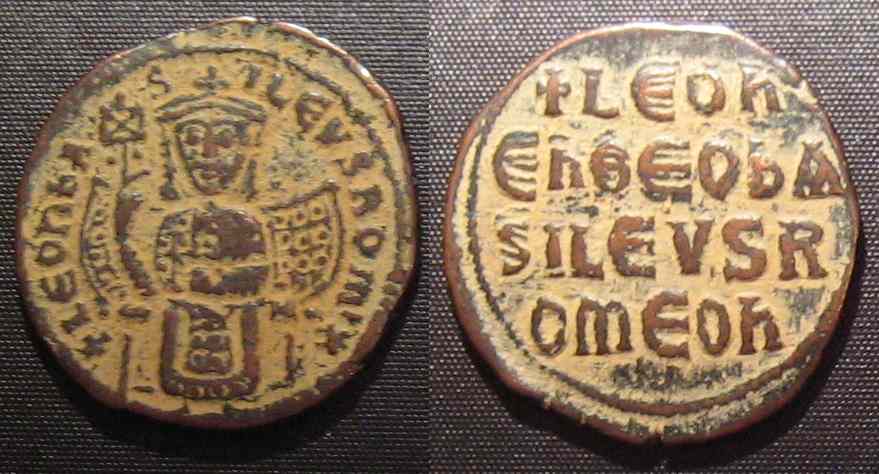 Leo VI, 886-912
Leo VI, 886-912
26 mm. 6.84 grams.
+LЄOҺbA-S-ILЄVSROM'
Leo VI in loros on throne with curved arms ("winged throne")
+LЄOҺ
ЄҺOЄObA
SILЄVSR
OMЄOҺ
Sear 1728
The design of this type is very similar to the last issue of Basil, which is an argument for it being Leo's first type.
Leo VI also issued another follis type in his name and that of his younger brother Alexander (third son of Basil I), who was almost completely on the sidelines, womanizing and drinking, until Leo died.
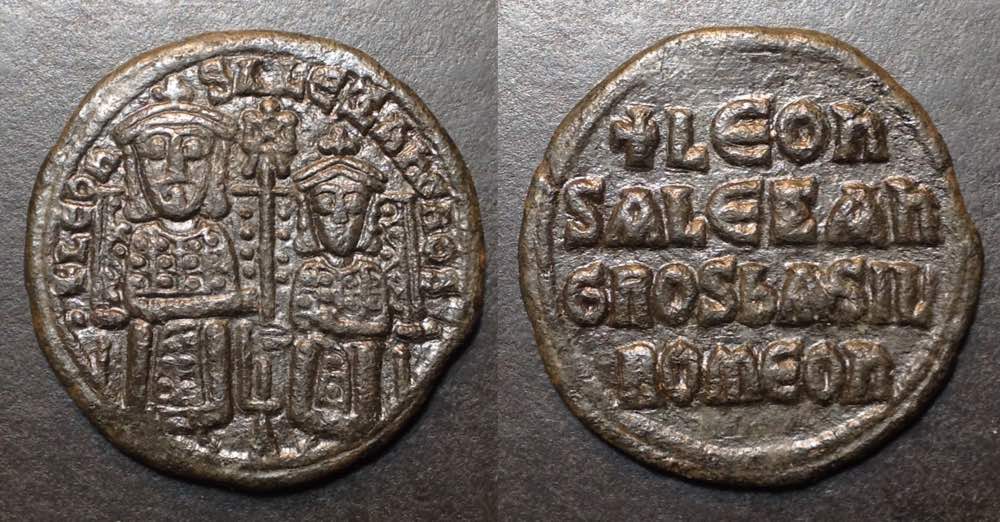 Leo VI and Alexander
Leo VI and Alexander
27 mm. 8.46 grams.
Leo VI on the left and Alexander, smaller, on the right
+LЄOҺ S ALЄΞAҺΔROS
+LЄOҺ
SALЄΞAҺ
GROSbASIL
ROMЄOҺ
Sear 1730
The chronological order of those two types of Leo VI is uncertain. Alexander was the third son of Basil and next in line to the throne, so maybe he had to be acknowledged immediately until he could be shuffled aside. If so, this might a joint issue early in Leo's reign. On the other hand, an argument for this joint type being later is that Leo was unable to produce an heir until his fourth wife had a boy in 908 and Leo was 42. So some time before then he may have despaired of ever having a son and felt the need to pick an heir. Finally, when he had a son of his own, he issued the next type.
The next type, probably Leo's last, is very common. It may be the most common Byzantine follis type.
 Leo VI, The Wise, 886-912.
Leo VI, The Wise, 886-912.
27 mm. 7.96 grams.
+LЄON BAS-ILЄVS ROM '
Four-line reverse legend:
+LЄOҺ
ЄҺΘЄO bA
SILЄVS R
OMЄOҺ
"Leo, by the grace of God, King of the Romans."
Sear 1729. Constantinople mint.
Go to Leo VI on the page on Byzantine coin emperors.
Go to the first page of "Introduction to Byzantine Coins."
Go to the Table of Contents for this educational site.
 Michael III, "the drunkard," 842-867 and Basil I, 867-886.
Michael III, "the drunkard," 842-867 and Basil I, 867-886. 25 mm. 6.98 grams.
25 mm. 6.98 grams. Basil I and his eldest son, Constantine
Basil I and his eldest son, Constantine Basil I (867-886) and Constantine (868-887)
Basil I (867-886) and Constantine (868-887) Basil I, the Macedonian, 867-886
Basil I, the Macedonian, 867-886 Another example of Sear 1712, with a much-different surface.
Another example of Sear 1712, with a much-different surface.

 Leo VI, 886-912
Leo VI, 886-912 Leo VI and Alexander
Leo VI and Alexander Leo VI, The Wise, 886-912.
Leo VI, The Wise, 886-912.